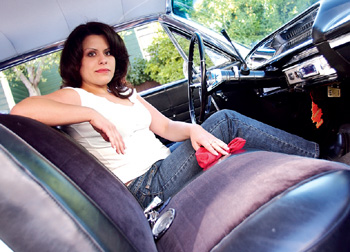
Photographs by Dave Lepori
Tough Enough: One of the few females in a sport built on machismo, Jennifer Crume gets props from the guys in her car club.
Lowriders
In San Jose, as in other barrios of Aztlan, Latinos flaunt their heritage with tricked-out, bouncing automobiles
By Vrinda Normand
FROM INSIDE THE 1964 Chevy Impala, a congested Santa Clara Street on a Friday night morphs into a brightly lit boulevard, perfect for riding low and slow. The hulking frame of the classic car creeps along at 10 miles an hour, leaving more than enough time to notice the shiny rims on the tires and the delicate gray stripes running along the gleaming silver body paint.
It's the weekend before Cinco de Mayo, and festivities are already under way. Lowriders in spruced-up vehicles have hit the streets to display their pride. Many boast Mexican flags on their hoods, rooftops, windows or antennae.
Jennifer Crume and Julie Victorica, twin sisters in their mid-20s from San Jose, lounge on the wide padded bench seat, each with one arm hanging out the front window. I'm in the back seat, peering out of the expansive windshield at the clubgoers crowding the sidewalks.
As we crawl to a stop at a red light, an old man driving a black limousine rolls down his window and asks with a sheepish smile, "What year is your car?"
"1964!" the girls answer in unison.
"Wow, you did a good job." Then he adds, "Yours is almost as long as mine."
Both women giggle as we pull away. "Does that happen to you a lot?" I ask. "Oh yeah," they answer. Usually the attention is great—admiring looks, compliments, whistles, catcalls, a few blaring horns—and all in good fun, except when some guys show disrespect by assuming that a woman behind the wheel of a cruiser is either out to get picked up or simply doesn't know what she is doing.
"I've had people tell me, What's up with the 69 in the back of the '64?" Crume says. "A lot of people trip out because they expect a man to be driving this car. But I'm like, if you can't handle it then that's your problem."
The girls, wearing jeans and sweat shirts, assure me that many guys think it's sexy that they devote as much time to their automobiles as their hair and nails. All the male members in their local car club, the Impalas, back them up.
As she flicks the ashes from her cigarette onto the street, Crume tells me that some of the guys "gave her shit" this evening for showing up with dirty "white walls" on her tires, though it was only lighthearted teasing. They have helped her find the best car parts and stood by her when she was trying to get out of an abusive relationship.
Victorica, who left her own Impala at home tonight, says her husband has a problem with her involvement with the car club. "What are you gonna do, drive around all night?" he asks her.
Sure. For both sisters, lowriding is a lot about showing off. "When I see other girls in clean cars, I'm like damn, I need to get on it," Crume says.
"It's about people who like cars, and if they happen to be Chicano, that's cool," Victorica says. Her husband teases her for thinking she is "more Mexican" because she has an Impala, but she explains that it's not strictly tied in with her ethnic identity.
For some, lowriding can be a reflection of Mexican-American pride, with the symbolic art that often goes into it and the strong family and community connection it brings. The sport has a history dating to the 1930s, when young zoot-suited Mexican-Americans, known as pachucos, lowered the back end of a Chevrolet with sandbags or by clipping several coils from the springs. According to a history by Lowriding Magazine, which, until the late 1980s, was published out of a San Jose office, Chicanos cruising around in tricked-out cars dates to the tradition of the paseo, a custom in which young people walked around the village square "blushing and making eye contact." The tradition eventually evolved into decorated cars.
But for Crume, the hobby mostly provides a network of friends and a nice break from her computer sales job. "It's not that deep, but I make it a part of my life like anything else. I put my heart into it. ... It's just something I'm proud of," she says.
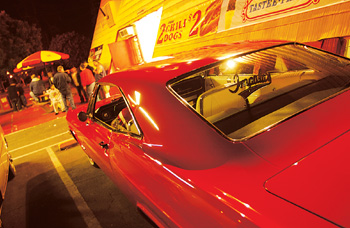
Drive Thru: King and Story was the lowrider hangout for many years. Now it's Sunday nights at the home of the world's largest hot dog chain.
Hitting the Switches
The broad streets of San Jose are home to a thriving car culture. Underneath the popular perception of lowriders being involved with drive-by shootings or gang activity lies an often-unrecognized art of self-expression, hard work and family tradition.
Auto aficionados of all ages restore vehicles as old as the cumbersome hardtops from the 1930s to the boxy sedans of the 1980s. For the ultimate eye-catching effect, they install small 13-inch tires with wire rims, lowering the cars mere inches above the ground.
Speed isn't really an option, because even a small bump in the road or a stray pebble can do serious damage to the car belly or the paint job, as one cautious driver explains. Still, some "pack" their lowriders with turbojet engines to show they have the power—even if they never intend to use it.
Organized in many small clubs according to car type or friendship, lowriders meet on weekends in the parking lots of Mexican supermarkets, fast-food restaurants and taquerias. They bounce their cars to rap music and holler at young women, who, on occasion, will flash their breasts outside of car windows or strut in short skirts that leave nothing to the imagination.
They cruise down King and Santa Clara streets in packs, stopping at gas stations to fuel up and wipe away spots on their windows. Sometimes, if a cop is out of sight and the lanes are clear, they'll break out with the hydraulics, making their cars hop or roll on the side wheels.
Mike Nevarez "hits the switches" for me in his '61 Impala. "Hold on tight," he warns with a mischievous grin over the peppy ranchera music booming from the stereo. I brace myself with the armrest because there are no seat belts (apparently this is legal if the original model didn't have them). As the car swings across four lanes in the middle of a left-hand turn, the right side rises a few feet in the air and sends me sliding across the leather seat.
Nevarez brings the Impala upright with a slight bounce, a lot like a roller coaster gliding to a stop. "You OK?" he asks. My heart is beating a little faster, but the experience was not as jerky as I had expected. I nod and say, "Yeah, that was great." And I want to do it again.
He pulls a few more tricks to show off, boosting the rear end and arousing excited hoots and scattered applause from passersby. The six other drivers—all with Chevy Impalas—pull alongside us in a street scene that could have come out of the '60s.
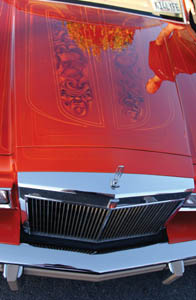
Spit and Shine: It isn't unheard of for lowriders to spend $35,000 rehabbing 1970s-era cars.
Menace to Society
The hint of violence, real or imagined, has never been far from the lowriding scene. Since the 1960s, lowriders have been considered "gangs on wheels," thugs willing to beat rival car-club members senseless for the smallest of infractions. In July 1968, lowriders squared off with police who tried to break up a rally against merchants along what was once home to the most visible lowrider scene in the country, Whittier Boulevard in East Los Angeles. Whittier merchants were accused of exploiting Chicanos and muscling out lowriders. Police wielding billy clubs moved in, tossing tear gas as rioters smashed windows and set fires along the boulevard.
In March 1997, a hit man murdered 60-year-old Leonard Miller in an East Side San Jose lowrider shop over what police describe as infighting over lowriding contests. Police believe the hit was authorized by Ruben Lopez, who owned a rival lowrider shop based in Long Beach, and was supposed to target Leonard Miller's son, Steve. Steve Miller reportedly wanted to change the rules of competition, threatening Ruben Lopez's business. The hit man apparently confused the father with the son. There are still warrants out for the arrest of Lopez and his brother, David.
But lowriders often accuse police of aggressive tactics because lowriders are predominantly of Mexican descent, and while adding their own flair to the sport, are a menace to society in the eyes of some law enforcement officials.
The cruisers are "endangering the lives of everyone else," says San Jose police officer Robert Foster, by turning the streets into a playground. People sticking their heads out of windows, driving too slowly and holding little sideshows create a "general hazard for the public," he says.
The week of Cinco de Mayo certainly kept the traffic cops busy. Foster says that by 9pm on the weekend, Santa Clara Street was gridlocked from the HP Pavilion to Highway 101. The congested roads frustrated drivers and made it difficult for emergency vehicles to get through.
According to Steve Dixon, a SJPD spokesman, 959 traffic citations were issued on Saturday and Sunday. This number includes all vehicles, not just those driven by lowriders, in the downtown and East Side areas.
Foster says many were for blatant violations, such as running red lights, speeding and not wearing seat belts. And while he says he would never pull over anyone unless he had probable cause, motivation could come from something as minor as a broken headlight, no front license plate or a sticker obscuring the front windshield.
Many of the lowriders, however, see this careful policing as harassment. They are often reluctant to take their cars out cruising, because they expect to get pulled over for such insignificant reasons.
Nevarez and his friend Sabatino Quintana say the most common excuse is "You match a description." Of course, these brown-skinned men with slick black hair hardly ever turn out to be the culprits. "After 20 times, I start hoping they really catch this guy," Nevarez jokes.
We all have a good laugh over Nevarez's most recent ticket—a $150 fine for loud music issued by a cop on a bicycle. That much? He smirks and demonstrates his reaction to the officer. "What ... I can't hear you," he mocks, putting his hand to his ear.
Then Nevarez sobers a bit, shrugs his shoulders and says, Well, that's how it is. They automatically think you're a gangster or out to cause trouble.
There are few people who give lowriders a bad name, Nevarez explains, pointing out a vintage pickup truck screeching to a stop at a red light. "See," he says, "they weren't paying attention and almost got in an accident."
Some lowriders get carried away, often under the influence of alcohol, and beat on each other in parking lot gatherings. But this behavior is usually limited to an adolescent crowd. Locals say many of the "hotheads" come from out of town and sully the scene late at night.
The members of the Impala car club, however, say they don't want to hurt anybody or make the roads a more dangerous place. Tomas Piedra takes his wife and four kids out cruising. He says he certainly wouldn't do anything to risk their safety.

Myth-Buster: Filmmaker Daniel Osorio hopes to debunk negative stereotypes.
Highway Patrol
Many lowriders are tired of the misrepresentations and want to reclaim the scene for the harmless, constructive hobby they see it to be.
Local filmmaker Daniel Osorio, who just released a documentary called Lowriding in Aztlan, is trying to challenge some of the negative stereotypes attached to lowriders. He and his wife, Katrina Jasso-Osorio (who produced the film), grew up in east San Jose, where cruising was a part of everyday life.
But they were dismayed by some of the misunderstandings held by people on the outside looking in, even among other members of the Latino community. Hollywood portrays virtually all lowriders as gang members, drug dealers and criminals—from the bad boys in Boulevard Nights to the cholos in Mi Familia.
These popular misperceptions, Osorio explains, lead to unfair treatment by the police. His documentary shows real-life footage of a lowrider being stopped by a highway patrolman in Santa Clara County. The young man was detained for a half-hour while the officer checked her code book for a violation she vaguely remembered and eventually never found. Another driver recalled being cited for no windshield wipers on a hot summer day.
Dixon of the SJPD denies that officers are specifically targeting lowriders. "Quite honestly, a lot of the people who cause problems are gang members, so it doesn't matter if they are in lowriders or highriders or whatever," he says.
In fact, lowriding can be a way to keep kids away from gangs and drugs, Osorio says. By spending all their spare time and money on renovating and personalizing lowrider cars or bikes, young people learn the value of hard work and find a gratifying artistic outlet.
Tamara Alvarado, the executive director of Movimiento de Arte and Cultura Latino Americana (MACLA), says lowriding is a way "to take your car out of the mundane, dreary world that we live in."
"Some people may say lowriders are only associated with bad people or gangsters, but it has given a lot of people a source of identity and pride that I think is really important," Alvarado explains.
That identity, while rooted in Chicano heritage, actually has close ties to the American pursuit of romance, using that classic American hook, the automobile. "Is lowriding an extension of the ego?" asks Dick DeLoach, senior technical editor of Lowriding Magazine. "Yes. There's a certain machismo about it, because it is predominantly a male sport to attract women. It's a sport about women and ego, in that order. You can say that about any car, really. Otherwise, everybody would be driving a Beetle."

Babe Magnet: Then as now, spiffed-up cars are as much about attracting the opposite sex as they are about showing mechanical expertise.
$13,000
The cool, white interior of Ray Madrigal's 1965 Chevy Impala smells like a combination of new carpet and vintage clothing. The ashtrays, the gas and brake pedals, the glove box, the speedometer—even a tissue-box holder hanging from the dashboard—are "stock" or exactly like the original version.
Madrigal spent three years ordering parts from catalogs and frequenting flea markets to find the perfect embellishments for his Impala. He collected all the pieces in his closet while he saved money to fix the engine, reupholster the seats and paint the Impala a smooth nail-polish red. A whopping $13,000 later, he says, "now I can just enjoy it."
He caresses the steering wheel and talks about all the memories connected to remodeling the car. One time, he was putting the finishing touches on it with his brother in their garage. He had just finished the paint job and was carefully maneuvering around the exterior to avoid scratching it. Then his cousin came in, leaned against an unsteady shelf, and accidentally caused a few boxes to come crashing down on the hood.
"I was like, Fuck!" he exclaims, covering his face with his hands, "I didn't want to look at it." When he got the courage to survey the damage, he saw a small dent and a scratch, nothing impossible to remedy. He graciously refrained from putting a dent in his cousin's head.
The tattoos on Madrigal's round arms are left over from a mischievous adolescence. He wears a sports jersey and gold chains around his neck, which he says make him a clear target for gang association. He often gets questioned about his choice to paint his car red, but he confesses that it has no controversial connection. It's just "his color."
"I grew up around gangs, but I'm older now. I can take care of myself, you know what I mean? I've done a lot of bad things, but I've done a lot of positive things, too," he says.
He currently owns a small house-cleaning business and is pursuing a degree in business management at San Jose City College. He's also won four trophies in the past year at lowriding car shows.
"When I'm having a bad day, and I just want to calm down or whatever, I get in my car, roll my windows down and put my radio on," he says.
But as much as he savors this activity, he would give it all up to provide for his little boy. He's thinking about buying a house someday, and if he needed to sell the car to do that, he would.
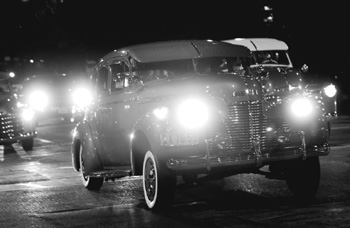
Zoot Suit Riot: Cars like this one, part of the Viejitos car club, harken back to the lowriding days of old.
Old School
The lowriding scene sprang out of the 1960s in the context of a growing Chicano movement. It started in urban neighborhoods in San Jose and Southern California as a way to affirm Mexican-American identity by "really showing people what you could do," says filmmaker Osorio.
He explains that the economic investment and individual energy that go into a lowrider create an uplifting symbol of social status, which was especially important for an ethnic minority that was fighting for power and equal rights.
The youth of 40 years ago, now grandparents who have passed on the lowriding tradition through the generations, still maintain a strong connection through their families. On May 1, members from four local car clubs gathered at Baylands Park in Sunnyvale to honor the recent passing of Chuie Martinez, the longtime president of Duke's Car Club.
His son-in-law, Fernando Aguilar, has inherited the leadership role, Martinez's 1937 Chevy Master Delux and a great respect for the lowriding legacy. Martinez's daughter, Enadina Aguilar, is expecting her second child in two weeks and fully intends to continue the tradition with her family. After all, she grew up with lowriding and "couldn't imagine life without it."
On the warm Saturday afternoon, children dodge between gleaming cars in the dusty parking lot while families chat on picnic tables over barbecued chicken, pasta salad and enchiladas. A live rock band strikes familiar Santana tunes, lending an energetic boost to the relaxed atmosphere.
A 3-year-old boy named Giovanni is stuffing a chocolate cupcake into his chubby cheeks and politely offers me one as I sit down with his parents. Almost everyone is wearing a T-shirt with the name of their car club, and a few men are gazing over a copy of Street Low Magazine.
It's obvious that most of the people rode here in style—dozens of classic cars are lined in rows that attract admiring browsers. A 1949 Aero Sedan catches my eye, a clunky, rounded car complete with a dinner tray for a hamburger and fries, as well as a portable pole with real drive-in movie speakers.
Jose Aldaz from the San Jose Inspirations Club shows me his "One Pinche Grand Prix," the name he gave to his 1983 Pontiac (pinche is the Spanish equivalent of fuck). He's won many awards for the intricate paint job, a delicious berry color with light rainbow stripes contrasted against a pure white interior.
The car next to his is a similar model and color but with more elaborate artwork. Murals on the sides, trunk and even on the engine itself display Aztec gods, indigenous pyramids, the Chicano eagle and a few scantily clothed women.
Aldaz says these are the "old-school" cars that helped define the prominent lowriding scene at King and Story roads "back in the day."
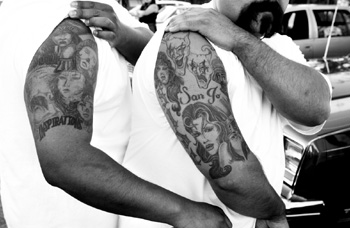
Me Against The World: Despite the rough look and a history of squabbles with police, lowriders say they're harmless.
1988 Civic
Osorio's documentary shows how lowriding has changed over the years and is now enjoyed across ethnic and national boundaries. As one mural painter put it, "It's a Chicano thing, don't get me wrong, but it's open to everyone now."
Car shows, in which lowriders are recognized for their creative efforts, are held around the globe from Japan to Europe. Even within the Bay Area, non-Hispanic lowriders are welcome in the clubs, as several Caucasian and Filipino members testify to in Osorio's film.
With his pale freckled skin and sandy blond hair shaved close his head, Gilbert Lara stands out from many of the other lowriders. But this heavyset man wearing a leather vest proudly baring his tattoo-covered arms seems perfectly comfortable at the predominantly Mexican-American barbecue.
"I'm half Mexican, but I look more white," he says. "I don't have any problems. No one tells me I should be hot rodding. The door is open to everyone."
Lara grew up in east San Jose and became fascinated with lowriding in the fifth grade when he read about it in a magazine. He started saving money from his paper route and fixed up his first lowrider bicycle. At 14, he was ready to move to four wheels and spent a couple of thousand dollars working on his Monte Carlo in auto shop class.
Now, at age 36, Lara hasn't given up the sport. He tried for a while when he started a family and traded in his lowrider for a convenient 1988 Honda Civic. But he couldn't resist transforming the compact car—he installed hydraulics, lowered the frame with 13-inch wheels and even painted it with traditional pin stripes.
He launched a small club called Kool Impressions eight years ago but says all the clubs are interconnected in the spirit of brotherhood. His kids have godfathers in other groups.
Lara's eldest daughter, 13-year-old Tiana, has staked her claim on his '64 Chevy Impala, which she fell in love with after she got to work the hydraulic switches at the Santa Clara County Fair parade six years ago. Her eyes light up as she explains how she gets to help her dad fix cars by handing him tools.
The majority of the lowriders are men, but they seem ready to pass the tradition on to both sons and daughters. Aldaz has two sons and is happy to see that his 8-year-old daughter is equally interested. The other day she was playing with a toy car and began to tilt it to on its side.
"What are you doing, honey?" he asked.
"I'm checking my pumps," she responded, referring to the hydraulic devices that lift the vehicle.
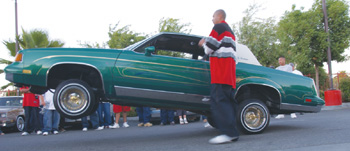
Revolution
Jennifer Crume got her first model car when she was 10 years old, and she has held on to her dream ever since. "I was a good girl. I went to school, graduated, got my ass a job and then bought my Impala," she says. "If you stick with it from a young age, it shows that you can achieve something you strive for."
Luckily, her mom understands her enthusiasm. "She knows I'll never sell my car, because it's what I do—it's my hobby," Crume says. She found her Impala from a friend at work and currently plans to redo the original black interior. Many of the guys in her club teach her about mechanics with full confidence that she can do anything they can.
Crume acknowledges that lowriding can be used for both positive and negative purposes because it really depends on what each individual puts into it. But she sees it as being an important activity because of its potential to make a difference.
The Impalas club goes beyond a love of cars to reach out to the community. Its members offer their services as escorts at quinceanera, weddings and other social functions. They also participate in toy drives during the holiday season and host car washes to raise money for community service organizations.
Osorio says the intentions of most car clubs are to promote social unity through common interests. Their main message is to dispel fear and get more people involved. Even on an individual level, lowriders are able to educate others by what they put on their car.
Political figures, cultural icons, religious symbols, personal representations and meaningful quotes all reveal a lowrider's situation and views on life. One driver, featured in Osorio's film, has been in and out of jail in past few years but comes back to his vehicle as a form of artistic expression. He had a mural painted on the hood that displays the curvaceous nude figure of his girlfriend, who works as a model and feeds his sense of pride in his car.
Another colorful exterior displays the saying of Emiliano Zapata, the famous Mexican revolutionary: "It's better to die standing than to live a lifetime on your knees."
But when the culture is clouded by stereotypes and suspicion, lowriders lose a lot of freedom to express themselves. The positive aspects of the sport become invisible in a society that is unable to see beyond the brown skin of a driver.
"It's a shame," Osorio says, "because a lot of people are missing out on what lowriding has to offer."
Send a letter to the editor about this story to letters@metronews.com.
[ Silicon Valley | Metroactive Home | Archives ]
![[Metroactive Features]](/features/gifs/feat468.gif)